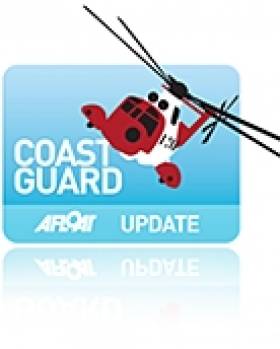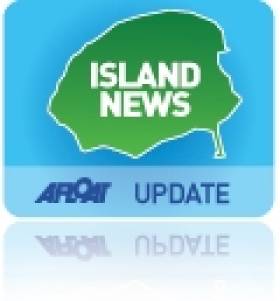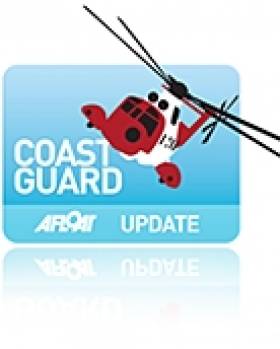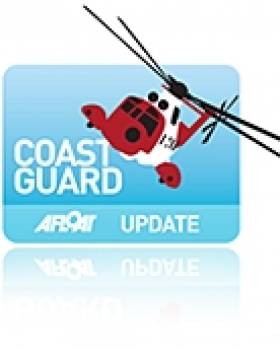Displaying items by tag: Coast Guard
Shannon Coast Guard Helicopter Rescues Spanish Trawler Man
The Shannon Coast Guard helicopter has medevac'ed a Spanish crewman from a trawler 120 nautical miles SSW of Mizen Head, in County Cork, one of the extreme points of the island of Ireland.
First Search and Rescue Missions for Welsh Coastguard Helicopter
The new HM Coastguard search and rescue helicopter based at St Athan was sent to its first tasking within an hour of going live at the weekend.
Bristow Helicopters Ltd commenced SAR helicopter operations on behalf of HM Coastguard from the St Athan base on Sunday 4 October at 1pm.
Just 47 minutes later the first job came in, when the crew was sent to help a horse rider who had fallen in a forest in West Wales.
The winchman was lowered to the casualty through a gap in the trees and after the road ambulance arrived, they were moved to a nearby field where the aircraft had landed. The casualty was then flown to Cardiff University Hospital.
Just a few hours later, a second mission came through from the UK Coastguard. At 5.30pm, the crew was asked to help search for a 20ft fishing boat that had run aground about three nautical miles from Swansea.
The crew located the boat on Pendine Sands using the aircraft’s infra-red system and the 80 year-old sailor on board was picked up in good health. He was flown to Pembrey Airfield where he was met by Burry Port Coastguard Rescue Team and members of his family.
Ferryside Independent Rescue Boat towed the vessel back to its mooring at Ferryside.
#currach – The Ballina Quay Regatta fest is making a fantastic return to the quay from June 12th -14th and is set to reignite the nostalgia of years gone by with a spectacular line up featuring All Ireland Currach Racing, boat treasure hunts, fishing competitions, air displays, water skiing and much much more.
The event aims to be a fantastic addition to the already action packed summer calendar in Mayo North and is being presented by the Moy Estuary Boat club, supporting the Ballyglass Lifeboat RNLI service.
After 20 years, the regatta is finally making its grand return and will delight both visitors and locals with an array of magnificient events. Friday night will see a Pirate Treasure Hunt come to the quay, followed by the Rejoice Gospel Choir Concert and the Monarch of the Quay Disco; a perfect introduction to the weekend long entertainment.
The Wild Atlantic Way Discovery Point will host a super adventurous and enjoyable day on Saturday as the Quay will be awash with activity and craic. Stand Up Paddling Board and Kayak races will be taking place all day and there will also be a Fishing Competition in the lead up to the Ceili Mor which will have the entire crowd dancing and jigging as nightime approaches.
On Sunday 14th June, local resident, 92 years young Una Timoney, will cut the ribbon and Mr Chris Reynolds, Director Irish Coast Guard will also officiate at the opening ceremony. This will be followed by Children's Pirate Themed Fancy Dress Parade to the Quay. The Band 2 Brigade will headline on Sunday with an amazing live performace and the final day will also feature a craft fair and a stunning air stunt display, the perfect day out for all the family.
The excitement is surely building, as many of the residents bear fond memories of days gone by and previous regatta festivals in the Quay. Without a doubt, a strong sense of nostalgia surrounds the festival with much anticipation for the return of the regatta, bigger and better than ever before. 4 Team Mixed Relay Swim to Sheaf Throwing, Tug-o-War, and lots more fun and games, the programme of events for the weekend is certainly an impressive one.
Holyhead Coastguard Operations Centre (CGOC) Becomes part of New HM Coastguard Network
#coastguard – Holyhead Coastguard Operations Centre (CGOC) is to become part of the new Coastguard national network for the very first time this week.
Work has been carried out at the search and rescue coordination centre to upgrade the technology and introduce new systems. This means Holyhead CGOC will be connected to the National Maritime Operations Centre (NMOC) in Hampshire and other Coastguard stations around the country, which will be able to offer mutual support during busy periods.
From January 2015, Holyhead CGOC and the new national network will start to take on operations from Liverpool Coastguard.
The changes to Her Majesty's Coastguard will see the NMOC and 10 other CGOCs around the UK work together to manage the workload. There will be no reduction in rescue resources. The availability of Coastguard Rescue Teams, lifeboats, rescue helicopters and other rescue units will be unaffected.
Graham Clark, Maritime Operations Controller at Holyhead CGOC, said:
"The way we deliver the coordination of search and rescue operations on our coast and out at sea is changing. But the public won't notice any difference. If you call 999 and ask for the Coastguard, or issue a mayday broadcast, we will still be here to help you.
"The new national Coastguard network will be able to oversee and assist with operations around the whole of the UK. Here at Holyhead CGOC we're now part of this network, so we can call upon help from our fellow Coastguards elsewhere in the country, and also in turn help them out if needed.
"It's vital to remember though that the rescue teams in your community are unaffected. There will still be the same number of lifeboats, Coastguard Rescue Teams, helicopters and other rescue resources."
The new national network is scheduled to be fully operational by the end of 2015.
Remembering The First Cable Car In Ireland At Garnish
#cablecar – Lehanmore Community Co-Op at Garnish on the Beara Peninsula are planning a re-enactment of what they describe as "the first-ever cable car journey to an island in Ireland." writes Tom MacSweeney.
It will be held at Crow Head on Saturday, September 6 and will involve Kerry Mountain Rescue Team, Castletownbere Coast Guard and Castletownbere RNLI according to Paul O'Shea, the Co-op Chairman,
"The first cable car crossing was by a cable rigged up by a prominent farmer Tadgh Roger O'Sullivan from Scrivogue, Garnish, between the mainland and one of the islands to transport his sheep," Lynette Dewhurst, one of those organising the event, said.
"Tadhg's idea gave the impetus and led to the Dursey cable car, unique in Ireland and which is very well-known today. The re-enactment which we are planning will also be a joint training session between the rescue services. The actual setting-up of the re-enactment will be extremely interesting as ropes will be fired hundreds of feet above the Atlantic to then be moored between the mainland and an island. Members of the rescue service will then travel via the cable."
Shuttle buses will transport spectators from Lehanmore Centre to the demonstration site. As the viewing area is in close proximity to the sea, stewards will guide everybody.
"We are asking spectators to be prepared for all weathers as it is an exposed area and donation buckets will raise funds for Kerry Mountain Rescue. A series of talks will be held at Lehanmore Community Centre hosted by the rescue services, where there will be food and refreshments available throughout the day and the evening, with live music from 7pm till late."
Search for Missing Boy off Holyhead
#coastguard – Coastguards are this afternoon searching for a 12-year-old boy who is believed to have been swept out to sea at Aberffraw.
Holyhead Coastguard received a 999 call at around 12.30 this lunchtime reporting that three people were stuck on rocks in the estuary. Further information then suggested that two men had managed to make it back to shore, plus a young boy; however another youngster was caught in the large waves and swept out to sea.
The Rhosneigr, Holyhead, Bangor and Moelfre Coastguard Rescue Teams along with two Coastguard Sector Managers are currently involved in the search, alongside the RNLI lifeboats from Porthdinllaen, Holyhead, and Trearddur Bay, the search and rescue helicopter from RAF Valley and North Wales Police.
#coastguard –The Irish Coast Guard strongly urges people not to engage in activities that put themselves at risk by diving or swimming in places that are not recognised recreational areas and may pose underwater dangers that are not readily obvious. Swimmers are literally jumping into the unknown, and there may be submerged objects which are not visible and which may cause serious injury.
The Irish Coast Guard advises people to only swim at beaches and waterways where lifeguards are on duty, to obey the safety flags indicating whether it is safe to swim, and to always avoid swimming in locks and weirs.
With the warmer weather over the last few days many people are taking to the water and enjoying outdoor activities. Last year the Irish Coast Guard saw an increase in incidents, and incidents are up again this year. The Coast Guard is urging everyone to heed the advice and enjoy the water and coastal activities in a safe manner throughout the summer.
Speaking ahead of the weekend Declan Geoghegan, Manager at the Irish Coast Guard, said: 'With the advent of good weather it is extremely important that people take extra precaution with regard to personal safety when engaging in water activities, especially where young children are concerned'.
Swimming
Only swim at beaches and waterways that have lifeguards on duty and pay attention to the safety flags, avoid locks and weirs. Ask the Lifeguard for advice about safety and water conditions and adhere to their instructions.
Never go out on the water, including rivers and lakes, having consumed alcohol.
Be able to swim. Get the proper training to stay safe.
Never go out alone.
Familiarise yourself with the local area, be aware of your own capabilities.
Swim parallel to the shore and not in deep water.
Keep warm before and after swimming.
Have a means of alerting the emergency services.
Avoid using inflatable toys, such as lilos and rubber rings, on the water.
Cliff Walking
There is safety in numbers, so never be alone if possible. Let somebody know when and where you are going and what time you will be back. Stay well away from the cliff edge, both top and bottom. Don't attempt to rescue people or pets if they fall over the edge. If assistance is required dial 112/999 and ask for the Coast Guard.
One Man & His Dog Rescued From Yacht
#coastguard – A Coastguard-coordinated rescue in the Bristol Channel last night (Thursday 24th) has underlined the importance of ensuring a vessel is seaworthy and properly equipped before taking to the waves.
Just before midnight, the Swansea Maritime Rescue Co-ordination Centre were contacted by the police who had received a call from a mariner, accompanied only by his dog, whose 17ft sailing boat had become stranded mid-Channel, just south of Lundy Island, after the outboard motor failed.
Upon further investigation it was discovered that the vessel was one of the least seaworthy that Swansea Coastguards had encountered in a good while: its hull was leaking, the mast was missing, with an old windsurfing rig serving as a poor substitute; the boat had no lights, no VHF radio – the sailor contacted the emergency services on a mobile phone – and his GPS device wasn't working, so he was unable to give his position. Coastguards had to use onshore telecommunications beacons to estimate his location to within 30km.
The optimistic voyager, who had also neglected to carry any charts, informed Coastguards that he was en route to the Hebrides, having set out from Instow, North Devon.
Coastguards had to use onshore telecommunications beacons to estimate his position to within 30km. This enabled them to task the search and rescue helicopter from Chivenor who spent two hours searching for a boat in the dark with no lights on, and just after four in the morning the sailor and canine companion were winched from the boat. RNLI's Appledore lifeboat was tasked to recover the vessel from a position 2.5 miles SSW of Lundy so that it was no longer a danger to shipping in the busy Bristol Channel. The volunteer lifeboat crew returned to station at 0915 in the morning, ready for a full day's work.
Bernie Kemble, Swansea Coastguard Watch Officer, said: "So many things were wrong with this gentleman's boat and lack of preparation that the situation was almost comical. He had taken to sea in what was effectively a leaky fibreglass hull, without even the most basic communications and safety equipment.
"Thankfully, weather conditions were calm, he was avoided by other vessels in the area and he was able to use the only piece of communications equipment he had to hand – his mobile phone – to raise the alarm. However, the situation could have been far more serious and he and his dog were lucky that they were rescued promptly.
"We would remind anyone in trouble at sea or on the coast to dial 999 and ask for the Coastguard."
The sailor and his dog were both reported to be unharmed by their ordeal.
Superyacht Names, Marine Crying & Fog at Sea is Frightening
#islandnation – We were beating on port tack up past Cobh. It was a pleasant night's sailing in Thursday night's cruiser league race out of Monkstown Bay Sailing Club. Then the VHF came alive with the first radio call I have heard from the new Naval vessel, 'SAMUEL BECKETT' which had come up astern, returning from sea. The Naval voice courteously requested if 'ODD JOB,' the yacht on which I was crewing, would alter course, so that the State's ship could make her approach to the Naval Base at Haulbowline, off to our port side.
Our Skipper, John Hegarty, former Class Captain of MBSC Cruiser Fleet, acknowledged with equal courtesy and called a tack so 'ODD JOB' came about to go astern of 'L.E SAMUEL BECKETT' which could then swing across river, gliding into her berth at the Base.
We then brought 'ODD JOB' about again and returned to the racing fray. The alteration cost us first place on handicap by two minutes and forty seconds, but it was the courtesy of good seamanship and it set me to thinking again about the names which are attached to boats, remembering the controversy there had been about the naming of the 'SAMUEL BECKETT.'
I have written about the issue in the current, Summer edition, of Afloat, asking "What's In a Name?" also raising the issue of being called an "islander" and about which it is worth listening to the interview on the July edition of my radio programme, THIS ISLAND NATION on this website (Click HERE to listen), with the last man alive of the islanders who were evacuated from the Blaskets, Gearóid Cheaist Ó Catháin.

Gearoid Cheaist O Cathain - The Last Blasket Islander
The names attached to boats – and ships – are interesting when you study them.
Ships' names are changed so regularly these days that a vessel can have a string of them and former names can be seen, painted over, on the bow and stern of ships. The old adage that it was unlucky to change the name of vessels no longer seems to apply, though there are quite a few who still believe in this.
I don't, I have changed the name of every boat I owned and still own.
So, how are names chosen and what do they mean?
There is still a fair degree of annoyance in Naval circles about the name Samuel Beckett being applied to their new ship and that the next one is to be called 'L.E JAMES JOYCE.'
The belief, amongst those who have been in regular touch with me about the names, is that it was former Defence Minister, Alan Shatter, T.D., who insisted on these choices, against strong feelings in the Naval Service for continuance of the tradition of mostly naming vessels after figures from Celtic mythology.
In the United States the politically-appointed Secretary of the Navy has the right by law to name its warships. In the late 18th and early 19th centuries, the U.S. Navy had no formal procedure for naming ships. It wasn't until 1819 that Congress passed an act stating that "all of the ships, of the Navy of the United States, now building, or hereafter to be built, shall be named by the Secretary of the Navy." The Secretary has fulfilled this role ever since, even though the passage expressly assigning authority for designating ship names was omitted when the U.S. Code was revised in 1925.

The Luna
The biggest superyacht registered under the British flag is now the 'LUNA,' built originally for the Russian billionaire, Roman Ambramovich, which was switched from Bermuda registration in a process handled by Watkins Superyachts, the London-based agency which is Luna's management and central charter agent. It is the world's largest charter expedition yacht in the world, 115 metres, built in 2010 by the German Lloyd Werft yard, at a cost of $185m.
Abramovich's 'other yacht' is named 'ECLIPSE,' which has its own advanced –missile system. Could that be to deal with Chelsea's misadventures?
The co-founder of Microsoft, Paul Allen, had his super yacht named 'OCTOPUS.' It has hatches at waterline level to form a dock for jet skis.
Amongst Richard Branson's stable was 'NECKER BELLE,' a catamaran for sailing around Necker Island which he owns in the Caribbean.
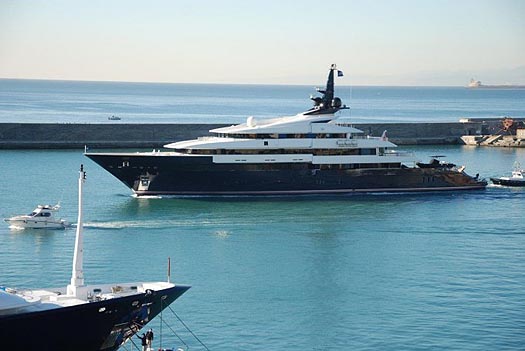
The Seven Seas
Steven Spielberg has 'SEVEN SEAS' which includes an indoor cinema.
Oracle boss Larry Ellison, whose funding of the winning of the Americas Cup dominated the sailing news last year, had 'RISING SUN' built, featuring an extensive wine cellar amongst other luxuries.' It is now owned by film producer, David Geffen.
And of course there were the Irish super yachts of Celtic Tiger times, such as 'THE ULYSSES,' once the subject of discussion in NAMA.

There are some clever names on boats – 'SHE GOT THE HOUSE' – now there must be a story behind that; 'CIRRHOSIS OF THE RIVER' and for those superyachts – 'WHO CARES.
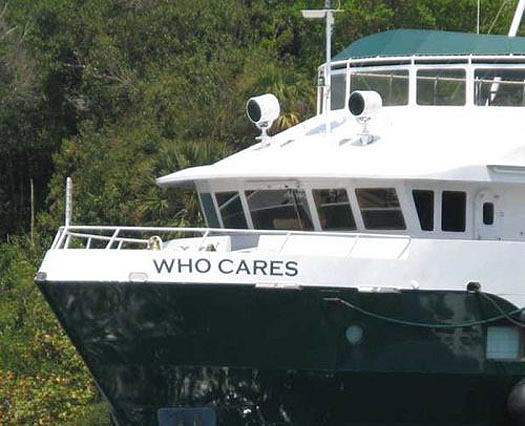

Then there are the regulars to be seen around marinas – 'AQUAHOLIC,' 'CAST AWAY,' 'DUN DREAMIN'; 'HAPPY HOURS'; 'SEA KNIGHT'; ' SEA MIST' 'Y KNOT' 'ALOAN AGAIN'; 'TOYSFORBOYS' 'DARK SECRET' and so on amongst them.....
So, what is in a name?
It should be indicative of confidence, I think, as well as of uniqueness and pride, without arrogance showing of course, unless that is you own a superyacht, when arrogance and naming seem to go together!
Fishing boats are often named by owners after their wives or children, or in a combination of both.
Owners of leisure craft vary widely in their choices, from the predictable to the somewhat bizarre and many shades between.
Commercial reasons can be used to name ships and change them to avoid legal difficulties.
But, does anyone notice what is in a name?
The public was not really energised by the Naval naming controversy.
The first boat I named was a 12 ft. Vagabond dinghy – 'LEGAN SCRIBE.' 'Legan' being traditional in the townland name of Monkstown so the local sailing club took pride in using it. This class of boats, unique at the time in Ireland, insisted that a name must indicate something about the owner. Being a reporter, mine was 'Scribe. The owner of a plumbing business had 'LEGAN LOO' and a butcher's boat was 'LEGAN LAMB'.
When I owned a Ruffian 23 I re-named it 'SCRIBBLER,' ignoring warnings about dangers inherent in changing the names of boats. I did similarly when moving onto a Sadler 25, which I re-named 'SEASCAPES,' as the purchaser of the Ruffian insisted on keeping its name - though a later owner changed it. I was then broadcasting a programme of that name. When I sold the Sadler, its new owner kept the name. So on the Sigma 33 which I now own, I changed its name to 'SEASCAPES II'. The purchaser of the Sadler later changed its name back to an original name it had.
'
While my new radio programme is named 'THIS ISLAND NATION' I won't be re-naming my Sigma. Not for the present anyway. I have thought about it, but the family who sail with me are firmly against it.
THE COAST GUARD CRIER
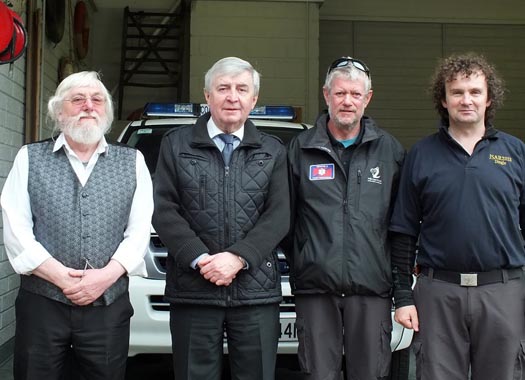
Cliff Winser, Afloat's Tom MacSweeney visiting Youghal Coast Guard station, Mike Lee, officer-in-charge and Tony Lawlor Coast Guard
What's in a name anyway?
For example, the name of Town Crier,' where a maritime man is to represent Ireland at the World Town Crier Tournament in Chester in England next month:
Youghal Coast Guard Station is located on the seafront, overlooking the harbour and Cliff Winser is an ardent believer in the importance of the service:
"There are two things I am particularly proud of in my life, being Receiving Officer for this station when it began operations and being Town Crier. I have been associated with the Coast Guard for a long time and have seen a lot of changes. This station was the first in the country to be completed and handed over to the service which was re-organised in the late 90s. The Coast Guard is not really sufficiently appreciated by the public, but then is any emergency service appreciated by the public until it is needed?" he told me.
"I have been Town Crier in Youghal since the 80s. It was historic and traditional to have a Town Crier and when it was being revived for a festival, I was chosen. Maybe it was my beard that got it for me! Anyway, it has been going since and the townspeople and tourists seem to like it and, with support from the town, I have been nominated for the world competition."
Cliff will be amongst 36 Town Criers from England, Wales, Germany, Holland, Australia, New Zealand, Canada, the Channel Islands and the USA, taking part:
"I'm doing a fair bit of practice at present. It all starts on August 15 and continues until a winner is chosen by the 25th, so it is a long tournament."
TIMELY RADAR WARNING
CHIRP Maritime is the Maritime Confidential Hazardous Incident Reporting Programme operated from the UK. It is a non-profit organisation which issues reports about safety-related issues or 'near misses' in all aspects of the maritime sphere. They published a 'FEEDBACK' newsletter which in its current edition has a detailed account of the close encounter which two yachts, travelling in company, had with a bulk carrier in fog in the English Channel. They were a 30ft. cutter and a 33ft.sloop. Even though they took what they thought to be avoiding action, the ship passed within a hundred yards, without seeing them. All three vessels, watching radar, in altering course to avoid each other, actually altered into the paths of each other at the same time.
The yacht crews were experienced, including an Ocean Yacht Master, an experienced professional Master Mariner and two Day Skippers. All concluded that fog at sea is frightening.
#coastguard – The Coast Guard is urging people not to go to sea in unsuitable craft. Coast Guard units all over the country are dealing with an increase in calls because of supermarket-bought inflatable craft being used at sea. The Coast Guard has experienced over 25 incidents in the last few days which involved leisure activities and any one of them could have resulted in disaster and loss of life.
Incidents varied from inflatables being blown out to sea, to people being isolated by the tide and also a notable increase in the use of cheap dinghies with small outboards. All of these can lead to disaster and the Coast Guard strongly advises against their use and also for PARENTS and GUARDIANS to be vigilant especially where young teenagers are purchasing such equipment.
The Coast Guard also had to deal with the dangerous use of Jet-skis.
Coast Guard units are currently running Compliance Monitoring Patrols in all coastal areas and strongly advise the use of PFD's (lifejackets) at all times.
If you are in difficulty or see someone in difficulty and requiring assistance dial 112/999 and ask for the Coast Guard.
Going out to Sea
Ensure your craft is fit for purpose.
Do not overload the craft.
Have a means of alerting the emergency services.
Wear a Personal Floatation Device, it could be the difference.
Lifejackets are just that LIFEjackets, and are of no use unless they are worn.
Personal Flotation Devices (PFD's) include lifejackets and buoyancy aids. It is vital to wear a lifejacket or buoyancy aid if your activity takes you near the water. This doesn't just mean the sea – it includes lakes and rivers too. If you enjoy sports like jet skiing, windsurfing, water skiing and canoeing, wearing the appropriate Personal Floatation Device will give you added confidence when in the water. Also, in the event of an emergency, it will help you remain afloat while the Search and Rescue services locate you.
Avoid using inflatable toys, such as lilos and rubber rings, on open water.
Also the Irish Coast provide free waterproof wristbands for children to assist the emergency services in contacting a parent or guardian should it be required. These wristbands distributed last year as part of the "Give us a Hand" campaign can be attained at Coast Guard stations nationwide.






























